1. Introduction
The development of pressure sensors dates back to 1954, and based on Smith's discovery, the anti-compressive effects of silicon and germanium were explored. Because of advances in intelligent robotics and wearable electronic devices, various new technological products based on flexible pressure sensors are developing at high speed. This includes the areas such as medical electronics, environmental monitored and wearables. Based on its excellent performance in the future flexible sensors can contribute more to major fields. The biggest advantage is that the objects can be detected according to the required deformation, which is a further success of the sensor. In biomedical monitoring and motion detection, flexible piezoresistive, flexible piezoelectric, flexible inductive, and flexible optical fiber sensors are commonly focused. Flexible sensors are stretchable, foldable, and extensible, creating a better detection of the human body and passing pulse signals. Better devices, better circuit design, better material, increased accuracy, and precision on shown data were necessary. The efficiency of energy and the small, thin sensor was what needed to be improved.
Piezoresistive pressure sensors are one of the common sensors. It utilizes the monocrystalline silicon piezoresistive effect. It uses a single-crystal silicon wafer as an elastic element; it is a process of utilizing integrated circuits on monocrystalline silicon diaphragms, connecting the resistor and placing the monocrystalline silicon wafer in the sensor cavity. The monocrystalline silicon generates strain when the pressure changes, the strain resistance will be proportional to the measured pressure, then the output of the corresponding voltage will be the signal.
Graphene is one of the most common flexible substrate materials. Graphene is considered the best-fit material for manufacturing flexible sensors and other electronic devices by its inherent flexibility, and it can withstand the mechanical strain applied without reducing any electrical properties. MXene is like a hydrogel in the middle of metal oxide. Due to MXene's excellent properties: high conductivity, high specific surface area and excellent mechanical properties in the aspect of flexible pressure sensors have a wide scope of application prospects. MXene has an abundant functional group on its surface, which helps prepare functional nanocomposites. MXene is likely to be suitable for further discussion in the field of flexible sensors.
2. Flexible sensor
2.1. Flexible sensor introduction
The flexible sensor comprises stretchable, foldable, extensible, flexible materials, which can be detected depending on different needs; it is used in electronic skin, medical, aerospace, environmental monitoring, wearable and other fields.
2.2. Classification and characteristics of flexible sensors
The flexible sensor can classify based on its uses. The main flexible sensors often include flexible pressure sensors, flexible gas sensors, flexible humidity sensors, flexible temperature sensors, flexible electric field, strain magnetic field intensity sensing, flexible magnetic flux and impedance intensity sensors and flexible thermal flow sensors. Alternatively, flexible sensors could be divided into 5 categories depending on their sensing mechanism: flexible capacitive sensors, flexible piezoresistive sensors, flexible piezoelectric sensors, flexible inductive sensors and flexible optical fiber sensors [1]. The following are the property of most flexible sensor materials (Table 1).
Table 1. Comparison of various flexible sensor materials [2]. |
Active Materials | Perception Mechanism | Sensitivity (VKpa-1) | Minimum Detection | Maximum Detection (Kpa) |
Perflfluoroalkoxy Alkane | Piezoelectricity | 15 | - | 2.5 |
Polyvinylidene Difluoride | Piezoelectricity | - | 1 Kpa | 30 |
ZnO nanorod | Piezoelectricity | - | 3.5 Kpa | 31.5 |
Carbon Nanotubes/PDMS Interlocked microdome | Piezoresistivity | 15.1 | 0.2 pa | 59 |
ACNT/G/PDMS | Piezoresistivity | 19.8 | 0.6 pa | 0.3 |
Vertically Aligned/PDMS | Piezoresistivity | 0.3 | 2 pa | 10 |
Graphene-paper | Capacitance | 17.2 | 2 Kpa | 20 |
PDMS microstructure Organic Field Effect Transistor | Capacitance | 0.55 | 3 pa | 20 |
The major flexible substrate materials used are polyvinyl alcohol amine (PVA), polyester plastic (PET), polyimide engineering plastic (PI), polyethylene naphthalene glycol ester polypropylene (PEN) and many more. Sodium polydimethylsiloxane (PDMS) has 100% light transmittance, good chemical stability, strong plasticity and good water resistance, and it has now become a widely used flexible substrate material. Furthermore, metal materials are generally used to make wires and electrodes; usually, metal nanoparticles or nanowires are used, they can be sintered into thin films, and they have good conductivity. Carbon materials which often are graphene and carbon nanotubes, both have great conductivity. Carbon nanotubes can form polymer sensors by conducting electricity, and transparent field effect transistors (FETs) can be made by combining the two. Inorganic semiconductor materials, zinc oxide and sulfur oxide all have good piezoelectric properties. Organic materials: transistors have excellent properties of signal conversion and amplification. Also, the large scale of using flexible pressure-sensitive was fine. Transistors can be used as material for wearable sensors. The material can be roughly classified into metal and carbon systems (Table 2).
Table 2. Comparison of advantages and disadvantages of conductive fillers [2]. |
System | Classification | Advantages | Disadvantages |
Metal System | - | Good electrical conductivity Excellent chemical stability Preservative | Easy to oxidization Unstable electrical conductivity High hardness Difficult molding |
Carbon System | Graphene | Good electricity Low prime cost | Unstable electrical conductivity Hard to form chain aggregates |
Carbon Black | Excellent and stable electricity Easy for preparation Low prime cast Rich in diversity | Easy to reunite | |
Carbon Nanotubes | Good electricity Great surface area | Hard to be prepared High cost |
Nanomaterials have four main characteristics, surface effect, small size effect, quantum size effect, and quantum tunneling effect. Because of their large specific surface area, nanoparticles can be used as highly active catalysts or adsorbents, which makes the prospect of nanomaterial application very important. New properties emerge when there are particles with acoustic, optical, electrical, magnetic, and thermal properties as small as nanoscale. Nanomaterials with good flexibility also have special properties: superconductivity, special mechanical properties, optical properties, magnetic properties and thermal properties. Nanomaterials are widely used in all areas [3].
3. Classification and characteristics of flexible sensors
3.1. Photoelectric pulse sensor
The mode of measurement of this type of sensor is called light-rated PPG (PPG). The basic theory is that when a beam of a specific effective wavelength irradiates the surface of the human skin, the beam can enter the skin, then transmit or reflect, and automatically send it back to the surrounding photoelectric automatic receiver equipment (Figure 1). During this process, under the influence of the absorption attenuation of skin, blood vessels, and muscles, the intensity of light received by the tester equipment will be weakened. The absorption of light by the skin and muscle is considered constant. Still, the heart has an active cyclical contraction and relaxation, so adequate actual blood volume produces a pulsatile change. When the core is diastolic, the peripheral blood flow is the lowest, the blood's absorption of light is in the weakest state, and the tested light intensity is the lowest; similarly, when the heart contracts, the tested light intensity is the largest, so the light intensity obtained by the photoelectric automatic receiver device will change with the corresponding rhythm of the pulsation. Therefore, the digital pulse signal of the human body can be measured as a photoelectric power conduction signal. The advantages of PPG are its non-invasiveness, low impact, low energy consumption, etc. Therefore, it is widely used in wearable devices, such as artificial intelligence wristbands such as the Apple Watch, which are tested by measuring the actual absorption of green and infrared light.
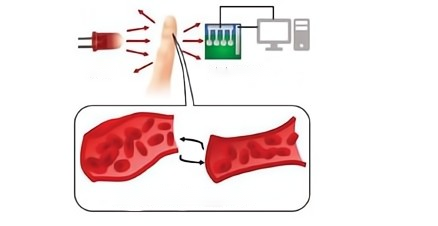
Figure 1. Photoelectric pulse detector [4].
Because the digital pulse signals collected by the PPG sensor are aliased digital signals from veins and arteries, they are more susceptible to the influence of external light sources, which results in a relatively high dependence on the practical components of blood. At this moment, the pressure sensor can be regarded as a mode of timely online collection and registration of digital pulse signals. This method has a high degree of measurement accuracy and can simulate the pulse diagnosis of traditional Chinese medicine very well to facilitate the acquisition of pulse data information. The pressure-type pulse sensor indirectly collects pulse data information by sensing the pressure change caused by the pulse beating (Figure 2). Concerning the differences in the basic theory of its work, it can be divided into rated action capacitive, piezoelectric, and piezoresistive pressure sensors.
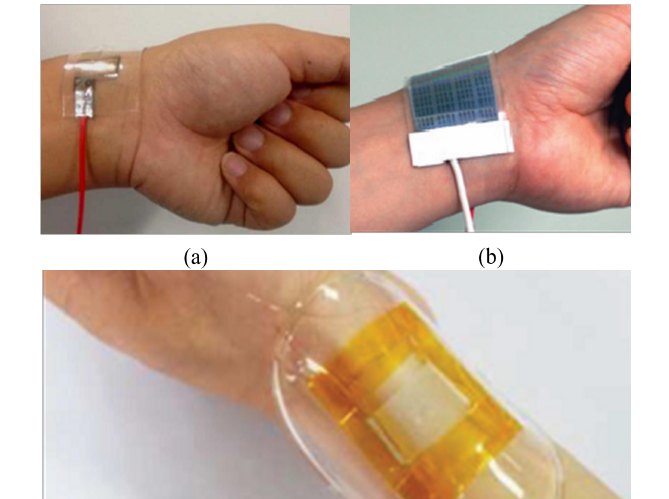
Figure 2. Pressure pulse sensor [5].
A capacitive pressure sensor is a rated capacitor and a sandwich structure consisting of two parallel upper and lower plates and a dielectric layer (Figure 3). Capacitive pressure sensors are characterized by their high flexibility and short reaction times, which make them outstanding in function. Flexible capacitive pressure sensors, a typical application, is the mode of modifying the surface layer of the upper and lower plates and the dielectric layer microstructure to efficiently control and manage the relative effective area and the actual distance between the plates, thereby improving the function of the sensor. Analytical researchers have recently developed many new capacitive pressure sensors, from silicon-based rigid devices to flexible electronic devices for polymeric organic matter. The above sensors are used in large quantities, especially molecular thin film wearable devices that simulate human skin.
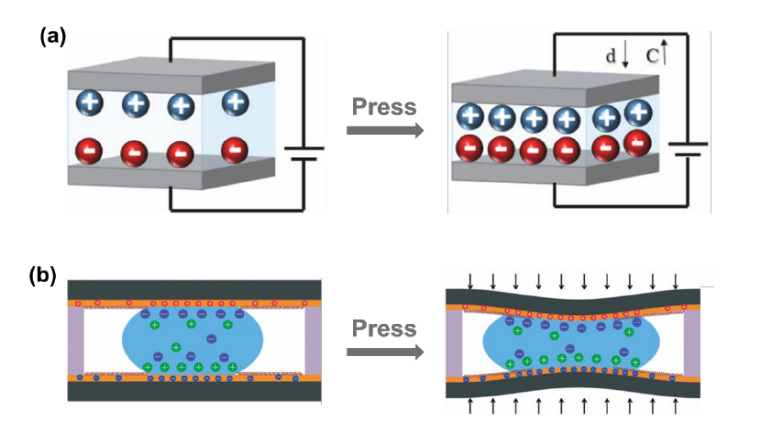
Figure 3. Capacitive pressure sensor [6].
Piezoelectric pressure sensors convert a pressure signal into a voltage signal type based on the piezoelectric effect of sensitive material. When the piezoelectric material is deformed under the action of external forces, the actual phenomenon of the application polarization problem in which the positive and negative charge detachment occurs inside the material causes the material to constrain the charge of the opposite electrical properties on the utterly opposite surface layer, forming a potential difference (Figure 4). The amount of order bound to the material's surface is proportional to the magnitude of the external force it is subjected. The polarization phenomenon will disappear as the external force is removed. As passive sensors, piezoelectric pressure sensors play a unique advantage in the practical application of wearable devices. At the same time, it can achieve fast response times in the order of microseconds. Inorganic materials (ceramics), organic materials (polymeric organic substances), and composites are essential materials for piezoelectric materials, among which piezoelectric thin film pressure sensors made of polymeric organic substance PVDF have been widely used in pulse measurement. PVDF polyvinylidene fluoride is a new class of piezoelectric materials that has more advantages than traditional types of materials:
Piezoelectric parameters are primarily used in equipment with high sensitivity.
More flexible mechanical strength, thinness, and shape selectivity that can be processed are especially important in preparing wearable, flexible equipment.
Good chemical stability and sustainability because the production of fluorine atoms in its molecular chain objectively exists, prompting it to have excellent thermal stability continuity, corrosion resistance, and maintain good functions in high temperatures and high humidity.
The frequency reaction range is wide.

Figure 4. Piezoelectric pressure sensor [7].
The piezoresistive flexible pressure sensor is a power conduction signal formed by sensing the change of rated working resistance caused by an external force to intuitively obtain the change of external force (Figure 5). When the external force acts on the automatic intelligent sensing point of the sensor, its rated resistance value and external force will be inversely proportional to change; that is, when the pressure tends to zero, the larger the rated resistance value, the greater the pressure, the smaller the rated resistance value. There are many types of sensors. According to the single device and digital signals automatically and intelligently calculating the system's characteristics, it has gradually developed into a pressure sensor with the largest number of applications.
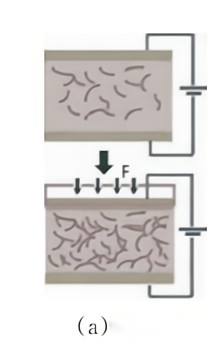
Figure 5. Piezoresistive flexible pressure sensor [8].
4. Fabrication and characterization verification of flexible pressure sensors
Artificial intelligence products of flexible sensors are closely related to daily life. Generally, they rely on Bluetooth to establish a connection with mobile smartphones. They measure daily parameters such as walking steps, heart rate, and skin conductivity ratio. Smart products with flexible sensors have been fully utilized in medical care, helping doctors to understand the actual condition of patients deeply and then determine a more appropriate treatment design plan. In medical treatment, it is possible to detect potential life safety problems in the human body early or even earlier [9].
4.1. Fabrication of flexible pressure sensor
Take the use of flexible pressure sensors to detect human pulse signals as an example to ensure a large extent of low production cost, high strength, and bending ability. To meet the different needs of various sports, PDMS and RGO are selected for production. Early common flexible substrate materials have been gradually phased out, such as metal foils, ultra-thin silicon wafers, and so on, have been unable to meet today's research needs and are now commonly used PI, PET, and PEN; these materials are typical flexible polymeric materials with good flexibility, dielectric properties, but not as pliable as typical ductile, flexible polymeric materials, so PDMS is used as the flexible substrate material, which has good flexibility. Because the main chain of PDMS is mainly composed of silicon-oxygen bonds, it has the characteristics of good flexibility and low production cost. RGO has a wide range of applications and good prospects in biomedical, environmental, catalysis and optoelectronics fields. Using RGO as a flexible sensing material has the advantages of low cost and electrical and mechanical properties similar to graphene. Compared with graphene oxide, the chemical structure of RGO is more stable. Here are the steps to make a flexible pressure sensor:
i) PDMS is formed by the mass ratio of the primary agent and curing agent, which is one of the reasons for the simplicity of PDMS production. First, the primary agent of PDMS and the curing agent are mixed and stirred evenly according to the mass ratio of 10:1.
ii) Pour the solution into a 10mm disposable circular petri dish, use an instrument to extract air bubbles, put it in an oven, and dry it at 60 degrees to solidify into a film. Repeat this step to make a bubble-free PDMS again.
iii) Graphene oxide (GO) at a concentration of 2 mg/mL was poured onto a bubble-free PDMS film and left to dry at room temperature. After the tape is completely dried, the film is formed and divided into two parts, the interdigital electrode and the conductive layer, the quality of the interleaved electrodes can also change the sensitivity and accuracy of flexible sensors.
iv) Place the material done in the third step under the laser engraving machine, engrave the patterned electrodes set in advance on the film, and obtain the redox graphene (ROG). Use the silver paste to connect the patterned electrodes to the wires and put them in a constant temperature blast drying oven for drying.
v) Take out the dried semi-finished product, use the undried PDMS evenly on the film outside the finger electrode and the conductive layer patterned electrode, then combine the two layers and put them into the constant temperature blast drying oven again. After drying, it is the RGO flexible pressure sensor [10].
4.2. Performance of the flexible pressure sensor
After the flexible sensor is fabricated, a multimeter scanning electron microscope can be used, combined with other equipment, to verify its basic performance.
4.2.1. RGO under SEM. The Scanning Electron Microscope consists of an electron optical system, a signal collection and display system, a vacuum system, and a power supply system. The working principle is to emit an excellent electron beam. Scanning the electron beam in the mode, using the signal strength of the position of the electron beam to form an image, has the advantages of a larger magnification, a larger depth of field, and a more three-dimensional image, and the sample preparation is simple but must be powered. Putting the ROG under the electron microscope, it can be observed that its surface is uneven and wrinkled, which indicates that it has a larger surface area (Figure 6). Moreover, the larger surface area will make the flexible sensor more sensitive.
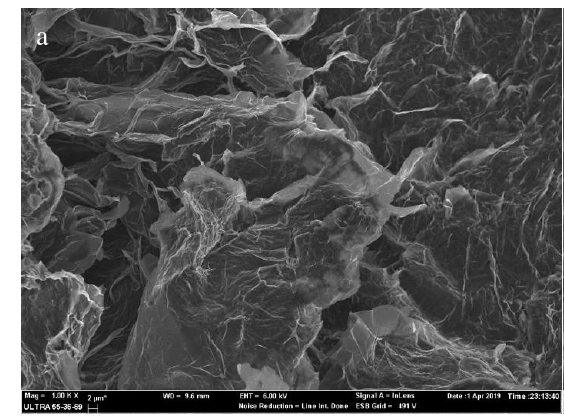
Figure 6. ROG under SEM [10].
4.2.2. Electrical properties of flexible pressure sensors. Connect a flexible sensor to the device and test its IV curve for different pressures. The total resistance Formula of the piezoresistive sensor is Rs=Rd (resistance value of the conductive layer) + Rc. The size of the Rd resistance is only related to the nature of the conductive layer itself, so it is immutable. The change in the size of the RC resistance value is affected by the change in the contact surface area so that it can convert the pressure signal into an electrical signal. After the equipment is connected to the flexible pressure sensors, it can be found that the IV curve changes linearly (Figure 7). The change range is evident and regular, which further shows that the change of the curve is due to the change of the resistance value, and when the pressure becomes more extensive, the slope also becomes larger, which means the resistance becomes smaller.
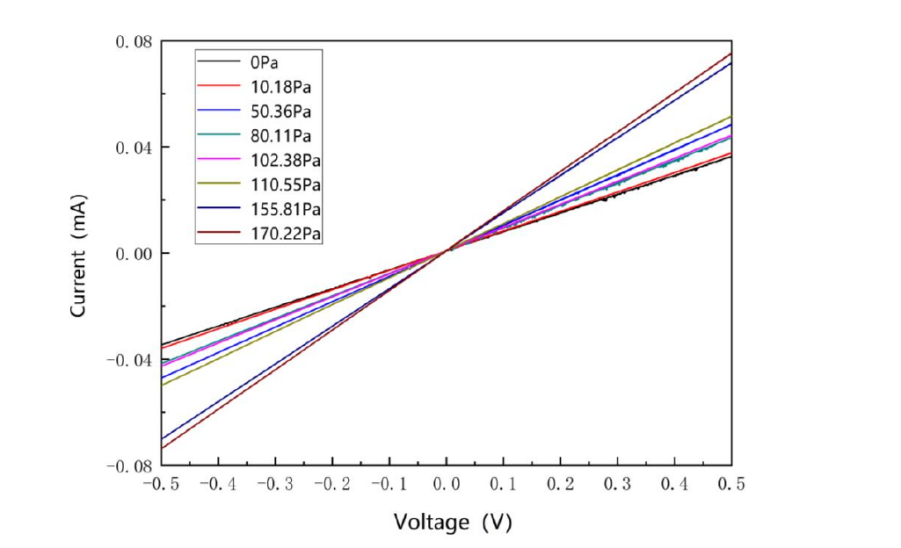
Figure 7. IV curve of a flexible pressure sensor [10].
4.2.3. Stability testing of flexible pressure sensors. The stability of the sensor can be verified by connecting the multimeter and using the tensile testing machine. Use the tensile testing machine to control the applied pressure and the falling speed of the upper part of the sample stage so that the sensor is continuously subjected to the same pressure in other to complete the stability test. Connect the multimeter to the sensor, use the value of the multimeter to obtain the resistance at this time, and further obtain the normalized resistance. Taking 60-70 and 709-719 in the whole 800 s as a comparison, it can be seen from Figure 8 that the changes of the two parts are the same, and it can be seen that their stability meets the requirements.
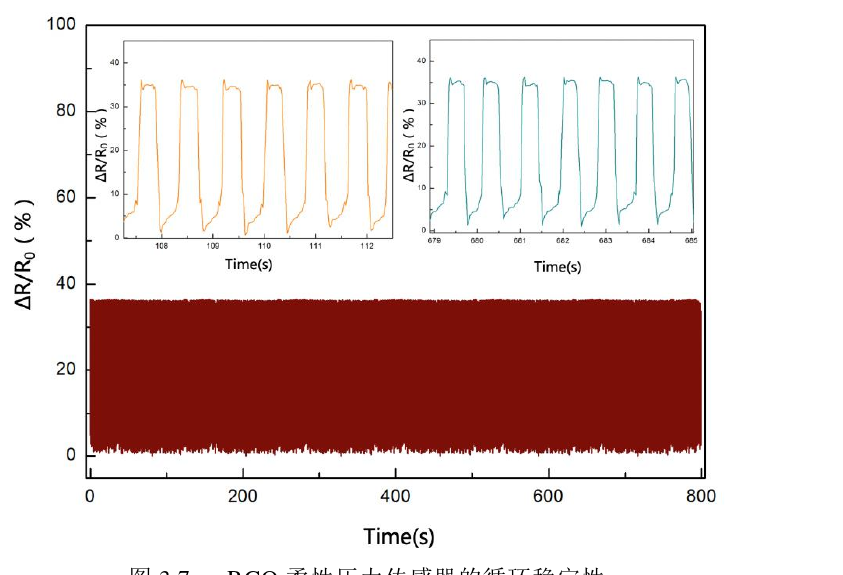
Figure 8. Cyclic stability of RGO flexible pressure sensors [10].
5. Conclusion
Flexible sensors have better ductility and bending than traditional sensors and can be applied to more fields and scenarios. It has a lower cost than flexible sensors and can still have high accuracy under the condition of portability. In the future, flexible sensors can be used in the field of smart wearables to help athletes detect human body signals and can also be used to detect damage to high-voltage wire joints. However, the researchers found that flexible pressure sensors still have many problems in scientific research, development, and life applications. In addition to a few base materials, such as PDMS, that meet the conditions, more materials still need to be excavated. In production, organic materials are more flexible, but the sensitivity to piezoresistive and capacitive signals is not as good as that of metal materials, and the development in the field of high-precision measurement is limited; Metal materials have better conductivity but limited bending; Moreover, the production of smart devices based on flexible pressure sensors still needs more experiments and tests to make flexible sensors completely go out of the laboratory and enter people's lives.
With the rapid development of science and technology, people's living needs have gradually changed from basic food and clothing to technology and convenience. According to forecasts by IHS, global shipments of flexible displays will increase to 792 million in 2020, and its market share will reach 64%. Smartwatches, bendable mobile phones, and giant advertising displays on curved walls produced with flexible displays are all changing humankind's lives. Flexible sensors could be applied to various scenes of life through the imagination and creativity of designers, and their potential application capabilities are considerable [11].



